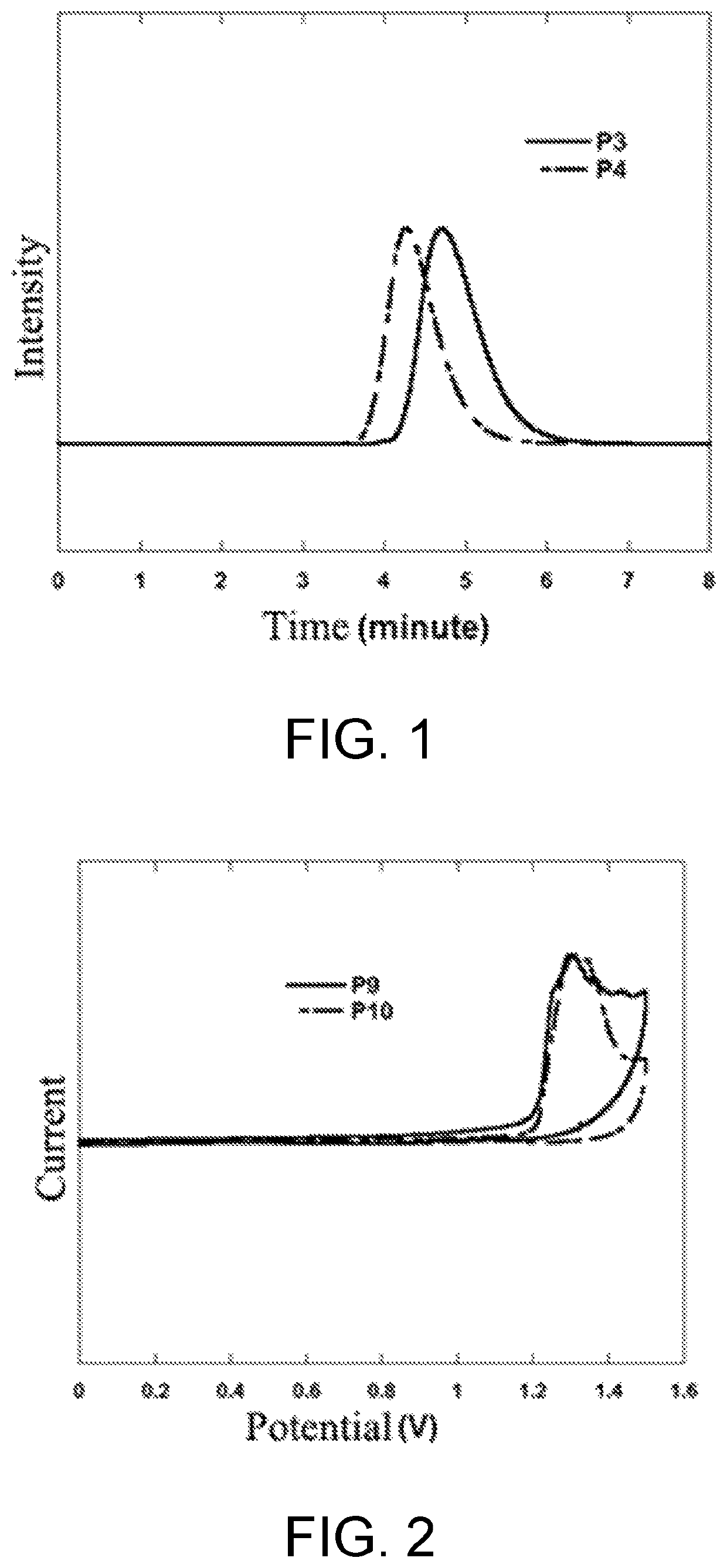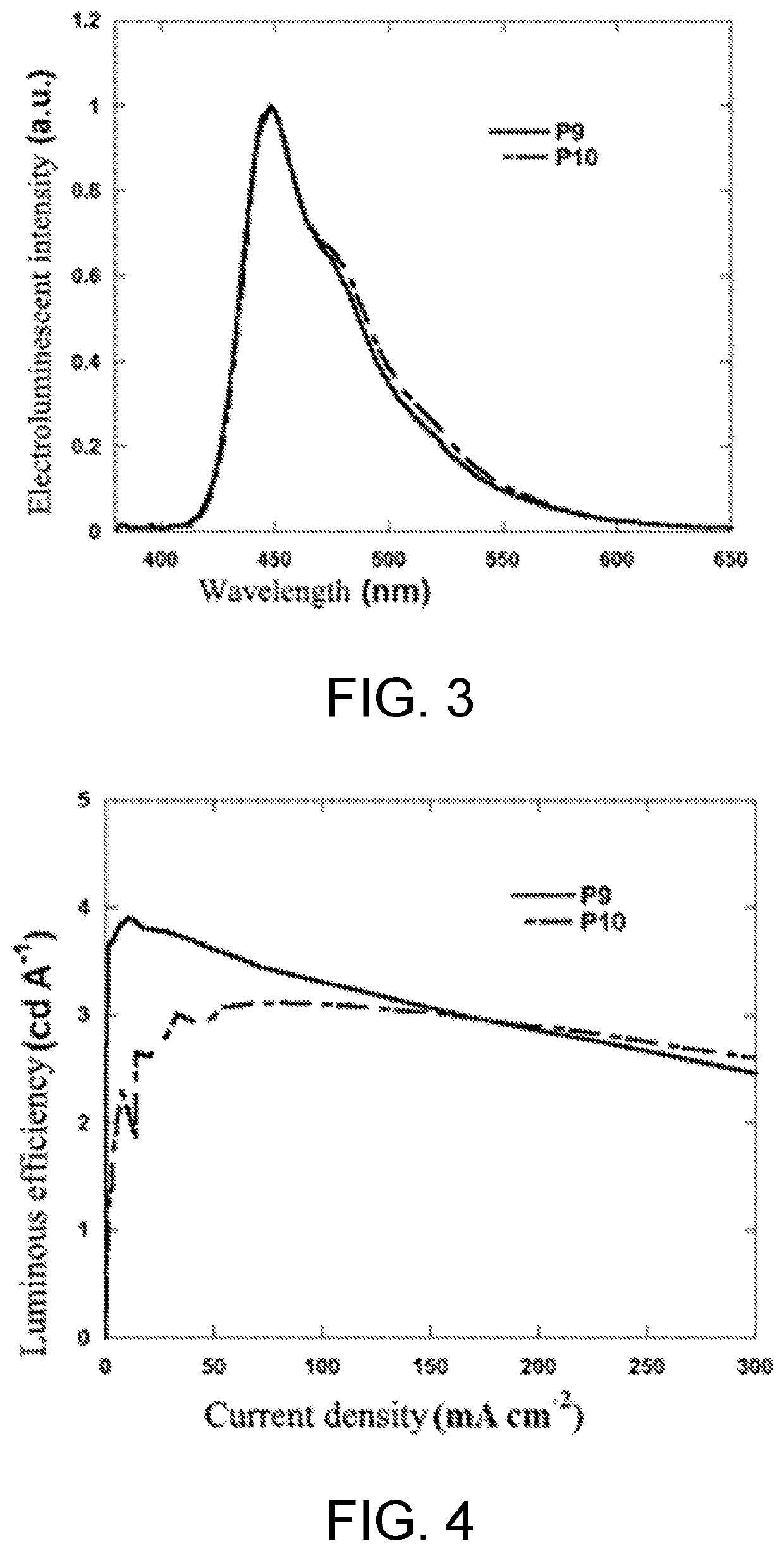Polymer containing S,S-dioxide-dibenzothiophene in backbone chain with content-adjustable triarylamine end groups and preparation method and application thereof
a technology of triarylamine end groups and polymers, which is applied in the field of organic photoelectric luminescent materials, can solve the problems of reducing the homo energy level of the polymer, increasing the hole injection barrier of the device, and reducing the hole-transport performance, so as to improve the electron-transport and hole-transport capabilities, improve the luminous efficiency and stability, and the effect of high efficiency and stability
- Summary
- Abstract
- Description
- Claims
- Application Information
AI Technical Summary
Benefits of technology
Problems solved by technology
Method used
Image
Examples
embodiment 1
Synthesis of poly(2,7-fluorene-co-3,7-S,S-dioxide-dibenzothiophene) with Different Molecular Weights (P1-P6)
[0041]
[0042]Synthesis of polymer P1: under the protection of nitrogen, 2,7-bis(4,4,5,5-tetramethyl-1,3,2-dioxaborolane)-9,9-dioctylfluorene (192.6 mg, 0.3 mmol), 2,7-dibromo-9,9-di-n-octylfluorene (131.6 mg, 0.24 mmol) and 2,7-dibromo-S,S-dioxide-dibenzothiophene (22.4 mg, 0.06 mmol) were dissolved in 8 mL of toluene, then tetraethylhydroxylamine aqueous solution (1 mL, wt %=25%), palladium acetate (2 mg), and tricyclohexylphosphine (4 mg) were added to react at 80° C. for 0.5 hour, and then the reaction was stopped. After cooling, an organic phase was precipitated in methanol (200 mL), filtered and dried to obtain the polymer P1. A polymer molecular weight was obtained by GPC test. (P1: Mn=4400, PDI=2.64)
[0043]Polymer P2: the reaction conditions were the same as those of the polymer P1 except that the Suzuki polymerization lasted for 1 hour. A polymer molecular weight was obt...
embodiment 2
Synthesis of poly(2,7-fluorene-co-3,7-S,S-dioxide-dibenzothiophene) with Different Contents of triphenylamine End Group (P7-P12)
[0049]
[0050]Synthesis of polymer P7: under the protection of nitrogen, the polymer P1 (150 mg) obtained in the embodiment 1 and 2,7-bis(4,4,5,5-tetramethyl-1,3,2-dioxaborolane)-9,9-dioctylfluorene (38.5 mg, 0.06 mmol) were dissolved in 10 mL of toluene, then 1 mL of tetraethylhydroxylamine aqueous solution (1 mL, wt %=25%), palladium acetate (2 mg), and tricyclohexylphosphine (4 mg) were added to react at 80° C. for 6 hours; then, 4-bromo-N,N-diphenylaniline (M1) (77.8 mg, 0.24 mmol) was added to perform a terminating reaction for 6 hours. Then the reaction was stopped. After cooling, an organic phase was precipitated in methanol (200 mL), filtered and dried to obtain a crude product, and then the crude product was extracted successively with methanol, acetone and n-hexane. The polymer was dissolved with toluene, and subjected to column chromatography purif...
embodiment 3
Synthesis of poly(2,7-fluorene-co-3,7-S,S-dioxide-dibenzothiophene-co-4,7-benzothiadiazole) with Different Molecular Weights (P13-P16)
[0058]
[0059]Synthesis of polymer P13: under the protection of nitrogen, 2,7-bis(4,4,5,5-tetramethyl-1,3,2-dioxaborolane)-9,9-dioctylfluorene (192.6 mg, 0.3 mmol), 2,7-dibromo-9,9-di-n-octylfluorene (115.2 mg, 0.21 mmol), 2,7-dibromo-S,S-dioxide-dibenzothiophene (22.4 mg, 0.06 mmol) and 4,6-dibromobenzothiadiazole (8.8 mg, 0.03 mmol) were dissolved in 8 mL of toluene, then tetraethylhydroxylamine aqueous solution (1 mL, wt %=25%), palladium acetate (2 mg), and tricyclohexylphosphine (4 mg) were added to react at 50° C. for 8 hours, and then the reaction was stopped. After cooling, an organic phase was precipitated in methanol (200 mL), filtered and dried to obtain the polymer P13. A polymer molecular weight was obtained by GPC test. (P13: Mn=8500, PDI=2.55)
[0060]Polymer P14: the reaction conditions were the same as those of the polymer P13 except that ...
PUM
| Property | Measurement | Unit |
|---|---|---|
| molar content mol % | aaaaa | aaaaa |
| molar content mol % | aaaaa | aaaaa |
| temperature | aaaaa | aaaaa |
Abstract
Description
Claims
Application Information
 Login to View More
Login to View More - R&D
- Intellectual Property
- Life Sciences
- Materials
- Tech Scout
- Unparalleled Data Quality
- Higher Quality Content
- 60% Fewer Hallucinations
Browse by: Latest US Patents, China's latest patents, Technical Efficacy Thesaurus, Application Domain, Technology Topic, Popular Technical Reports.
© 2025 PatSnap. All rights reserved.Legal|Privacy policy|Modern Slavery Act Transparency Statement|Sitemap|About US| Contact US: help@patsnap.com



